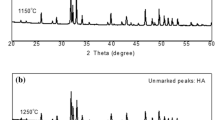The paper examines the production of Si-modified biogenic hydroxyapatite ceramics. The introduction of methylsilicic acid hydrogel in amounts converted to 2 and 5 wt.% Si and subsequent sintering at 600°C increase the specific surface area by 10 times, from 6.1 to 59.8 m2/g. The porosity of ceramics increases from 43.0 to 62.3% when the modifying addition reaches up to 5 wt.%, the compressive strength being equal to 27–33 MPa. The modifying addition also influences the structure and reduces the minimum grain size of the material from 0.65 to 0.1μm






Similar content being viewed by others
References
Atta-ur-Rahman (ed.), Studies in Natural Products Chemistry, Elsevier (2008), p. 954.
C. Exley, “Silicon in life: a bioinorganic solution to bioorganic essentiality,” J. Inorg. Biochem., 69, No. 3, 139–144 (1998).
E. Emanuel, “Silicon,” Annu. Rev. Plant Physiol. Plant Mol. Biol., 50, 641–664 (1999).
J. Loeper and M. Fragny, The Physiological Role of the Silicon and its Antiatheromatous Action, Plenum Press, New York–London (1978), p. 589
Q. H. M. Shawket Zaman, A. Takeuchi, C. Tanira Zaman, et al., “Fabrication of Si-substituted hydroxyapatite foam using calcium silicates,” J. Ceram. Soc. Japan, 116, No. 1349, 88–91 (2008).
X. W. Li, H. Y. Yasuda, and Y. Umakoshi, “Bioactive ceramic composites sintered from hydroxyapatite and silica at 1200°C: preparation, microstructures, and in vitro bone-like layer growth,” J. Mater. Sci.: Mater. Med., 17, 573–581 (2006)
C. Q. Ning, J. Mehta, and A. El-Ghannam, “Effects of silica on the bioactivity of calcium phosphate composites in vitro,” J. Mater. Sci.: Mater. Med., 16, 355–360 (2005)
G. Mestres, C. Le Van, and M.-P. Ginebra, “Silicon-stabilized α-tricalcium phosphate and its use in a calcium phosphate cement: characterization and cell response,” Acta Biomater., 8, No. 3, 1169–1179 (2012).
L. A. Ivanchenko, T. I. Fal’kovska, N. V. Danilenko, et al., “Structure and properties of a high-porosity glass ceramic containing biological hydroxyapatite,” Powder Metall. Met. Ceram., 38, No. 9–10, 448–453 (1999).
O. Sych, N. Pinchuk, A. Parkhomey, et al., “Morphology structure and properties of new porous biocomposites based on biogenic hydroxyapatite and synthetic calcium phosphates,” Funct. Mater., 14, No. 4, 430–435 (2007).
E. E. Sych, N. D. Pinchuk, and L. A. Ivanchenko, “Effect of sintering temperature on the properties of biogenic hydroxyapatite–glass composites,” Powder Metall. Met. Ceram., 49, No. 3–4, 153–158 (2010).
E. P. Podrushnyak, L. A. Ivanchenko, T. I. Fal’kovska, et al., “New biocomposites based on bone hydroxyapatite and their potential applications in biology and medicine,” Probl. Osteol., 1, No. 2–3, 98–100 (1998).
V. I. Luzin, S. V. Petrosyants, Yu. S. Plyaskova, et al., “Chemical composition of various sections of long cortical bones after implantation of biogenic hydroxyapatite,” Travma, 10, No. 3, 346–350 (2009)
D. V. Ivchenko, “Tactics of treating pathological fractures of extremities of patients with tumor diseases and benign tumors,” Ortoped., Travmatol., Protezir., No. 4, 12–15 (2006).
V. I. Luzin and A. A. Lubenets, “Growth, structurization, and shaping of skeletal bone in implantation of biogenic hydroxyapatite doped with manganese in different concentrations into the tibia,” Ukrain. Morfol. Al’manakh, 9, No. 3, 116–117 (2011).
E. P. Podrushnyak, L. A. Ivanchenko, V. L. Ivanchenko, and N. D. Pinchuk, Hydroxyapatite and Methods for Its Production (Options) [in Ukrainian], Ukrainian Patent 61938, IPC A61K35/32, A61K33/00, A61K6/02, A61P19/00; E. P. Podrushnyak, L. A. Ivanchenko, V. L. Ivanchenko (applicants and patent holders), No. 99095233; appl. September 21, 1999; publ. December 15 (2003), Bulletin No. 12, p. 7.
S. A. Goldstein, “The mechanical properties of trabecular bone: dependence on anatomic location and function,” J. Biomech., 20, No. 11–12, 1055–1061 (1987).
Author information
Authors and Affiliations
Corresponding author
Additional information
Translated from Poroshkovaya Metallurgiya, Vol. 54, Nos. 1–2 (501), pp. 83–90, 2015.
Rights and permissions
About this article
Cite this article
Sych, E.E., Pinchuk, N.D., Klimenko, V.P. et al. Synthesis and Properties of Si-Modified Biogenic Hydroxyapatite Ceramics. Powder Metall Met Ceram 54, 67–73 (2015). https://doi.org/10.1007/s11106-015-9681-z
Received:
Published:
Issue Date:
DOI: https://doi.org/10.1007/s11106-015-9681-z




